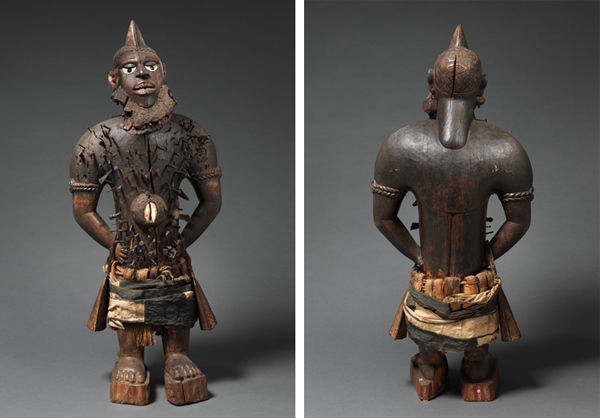
International Symposium on the Testing of Materials for Storage and Display of Cultural Heritage
On Wednesday, November 6th, 2019, thanks to the generous support of the Institute for Museum and Library Services, The Met hosted its first International Materials Testing Symposium. The symposium covers recent developments in materials selection methods in addition to both advanced and traditional materials testing tools. Many institutions continue to rely on the Oddy test, while others utilize advanced analytical methodologies such as gas and liquid chromatography to assess materials that are to be used in the display, storage or transportation of art and cultural heritage objects.
Highlights from the symposium include an in depth look at The Met's version of the Oddy test and how it compares to a paper version and the Photographic Activity Test (PAT) as well as GC/MS analysis using solid phase microextraction (SPME) and direct thermal desorption (DTD) techniques. The symposium also introduced rapid and inexpensive tests for sulfides or acids and techniques for active air sampling in pre-existing spaces and displays.
With eleven speakers and more than one hundred twenty attendees from a wide range of cultural heritage fields, the symposium garnered fruitful discussion about the needs in the field of preventive conservation to improve our ability to accurately evaluate a broad array of materials for those with and without advanced analytical capabilities.
Welcoming remarks and the eleven presentations are featured in the videos below.
Schedule of Events
Conventional materials tests and resources: overview and advances
[00:00:00] Welcome and Introduction Statements
Marco Leona, David H. Koch Scientist in Charge, and Eric Breitung, Senior Scientist, The Metropolitan Museum of Art
[00:03:48] The Fortuitous Interaction: A brief chronicle of offgassing effects on collection materials
Pamela Hatchfield, Robert P. And Carol T. Henderson Head of Objects Conservation, The Museum of Fine Arts Boston
[00:37:35] Survey of Different Methods to Assess Materials Used in Museums From Approved Lists to Piezoelectric Crystal
Jean Tétreault, Senior Conservation Scientist, Canadian Conservation Institute
[01:09:19] Updating The Met's 3-in-1 Oddy Test, Successes and Issues
Eric Breitung, Senior Scientist, The Metropolitan Museum of Art
[01:39:15] WHO KNEW?! An Overview of Materials Resources, Usage and Future Plans in AIC's Online Universe
Rachael Perkins Arenstein, Principal, A.M. Art Conservation
[02:10:47] Oddy Vs. PAT Smackdown!
Daniel Burge Senior Research Scientist, Image Permanence Institute
Advances in materials testing and pollution monitoring using analytical tools—Part One
[00:00:16] Selection of Low Emitting Material for the Construction of Display Cases Based on the BEMMA-procedure
Wolfgang Horn, Senior Scientist, Bundesanstalt für Materialforschung und-prüfung
[00:37:32] The Paper Test, a Novel Analytical Approach for a Semi-quantitative Oddy Test Alternative
Francesca Volpi, Andrew W. Mellon Fellow, The Metropolitan Museum of Art
[01:01:46] Development of a Semi-quantitative GCMS-based Thermal Desorption 'Toolbox' to Examine and Limit the Risk to Collections From Volatile Compounds
Eric Monroe, Supervisory Scientist, Library of Congress
Advances in materials testing and pollution monitoring using analytical tools—Part Two
[00:00:11] Oddy Testing and SPME GC-MS Analysis of Acrylic Adhesives Used in Museums
Catherine Stephens, Associate Research Scientist, The Metropolitan Museum of Art
[00:37:20] Determining Material Suitability by Direct Isothermal Desorption: Rigid PVC Boards for Vitrine Decks and Back Panels
Michael Samide, Professor of Chemistry, Butler University
[01:13:48] Making and Interpreting Pollution and Corrosion Rate Measurements During Exhibitions
Dr. David Thickett, Senior Conservation Scientist, English Heritage
Keep Exploring
Developing Tools and Methods for Selecting Materials to Display, Store, and Transport Art
The Preventive Conservation Science Laboratory (PCSL) is addressing widespread collections-care issues by developing a new test for the assessment of construction, storage, and display materials for use with organic objects.
Conservation and Scientific Research Projects
The Metropolitan Museum houses a world-renowned complex of scientific research and conservation facilities, each of which serves as a training ground for conservators from around the world. This project list provides a small sample of their research activities.
Handle with Care: A Mangaaka Power Figure's Journey from Rome to New York
Helina Gebremedhen speaks with Marco Leona, Christine Giuntini, and Ron Street about the multi-year process of preparing the Museo Pigorini's Mangaaka power figure for its unprecedented journey to the Metropolitan for display in Kongo: Power and Majesty.


